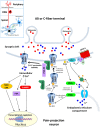Postoperative pain-from mechanisms to treatment
- PMID: 29392204
- PMCID: PMC5770176
- DOI: 10.1097/PR9.0000000000000588
Postoperative pain-from mechanisms to treatment
Abstract
Introduction: Pain management after surgery continues to be suboptimal; there are several reasons including lack of translation of results from basic science studies and scientific clinical evidence into clinical praxis.
Objectives: This review presents and discusses basic science findings and scientific evidence generated within the last 2 decades in the field of acute postoperative pain.
Methods: In the first part of the review, we give an overview about studies that have investigated the pathophysiology of postoperative pain by using rodent models of incisional pain up to July 2016. The second focus of the review lies on treatment recommendations based on guidelines and clinical evidence, eg, by using the fourth edition of the "Acute Pain Management: Scientific Evidence" of the Australian and New Zealand College of Anaesthetists and Faculty of Pain Medicine.
Results: Preclinical studies in rodent models characterized responses of primary afferent nociceptors and dorsal horn neurons as one neural basis for pain behavior including resting pain, hyperalgesia, movement-evoked pain or anxiety- and depression-like behaviors after surgery. Furthermore, the role of certain receptors, mediators, and neurotransmitters involved in peripheral and central sensitization after incision were identified; many of these are very specific, relate to some modalities only, and are unique for incisional pain. Future treatment should focus on these targets to develop therapeutic agents that are effective for the treatment of postoperative pain as well as have few side effects. Furthermore, basic science findings translate well into results from clinical studies. Scientific evidence is able to point towards useful (and less useful) elements of multimodal analgesia able to reduce opioid consumption, improve pain management, and enhance recovery.
Conclusion: Understanding basic mechanisms of postoperative pain to identify effective treatment strategies may improve patients' outcome after surgery.
Keywords: Ketamine; Multimodal analgesia; Postoperative pain; Pregabalin; Sensitization; Surgical incision.
Conflict of interest statement
Sponsorships or competing interests that may be relevant to content are disclosed at the end of this article.
Figures


Similar articles
-
EVIDENCE-BASED STRATEGIES FOR MULTIMODAL POSTOPERATIVE PAIN MANAGEMENT.Acta Clin Croat. 2023 Nov;62(Suppl4):107-114. doi: 10.20471/acc.2023.62.s4.16. Acta Clin Croat. 2023. PMID: 40463456 Free PMC article. Review.
-
A prospective randomized study to analyze the efficacy of balanced pre-emptive analgesia in spine surgery.Spine J. 2019 Apr;19(4):569-577. doi: 10.1016/j.spinee.2018.10.010. Epub 2018 Oct 22. Spine J. 2019. PMID: 30359764 Clinical Trial.
-
Postoperative pain--clinical implications of basic research.Best Pract Res Clin Anaesthesiol. 2007 Mar;21(1):3-13. doi: 10.1016/j.bpa.2006.11.003. Best Pract Res Clin Anaesthesiol. 2007. PMID: 17489216 Review.
-
Perioperative intravenous ketamine for acute postoperative pain in adults.Cochrane Database Syst Rev. 2018 Dec 20;12(12):CD012033. doi: 10.1002/14651858.CD012033.pub4. Cochrane Database Syst Rev. 2018. PMID: 30570761 Free PMC article.
-
Diagnosis and management of complications following pelvic organ prolapse surgery using a synthetic mesh: French national guidelines for clinical practice.Eur J Obstet Gynecol Reprod Biol. 2024 Mar;294:170-179. doi: 10.1016/j.ejogrb.2024.01.015. Epub 2024 Jan 17. Eur J Obstet Gynecol Reprod Biol. 2024. PMID: 38280271 Review.
Cited by
-
Green Light Exposure Elicits Anti-inflammation, Endogenous Opioid Release and Dampens Synaptic Potentiation to Relieve Post-surgical Pain.J Pain. 2023 Mar;24(3):509-529. doi: 10.1016/j.jpain.2022.10.011. Epub 2022 Oct 23. J Pain. 2023. PMID: 36283655 Free PMC article.
-
Skin/muscle incision and retraction regulates the persistent postoperative pain in rats by the Epac1/PKC-βII pathway.BMC Anesthesiol. 2022 Jul 18;22(1):230. doi: 10.1186/s12871-022-01771-w. BMC Anesthesiol. 2022. PMID: 35850627 Free PMC article.
-
Chronic Postsurgical Pain in Children and Adolescents: A Call for Action.J Pain Res. 2024 May 29;17:1967-1978. doi: 10.2147/JPR.S464009. eCollection 2024. J Pain Res. 2024. PMID: 38828088 Free PMC article. Review.
-
Herbal medicine for the management of postoperative pain: A protocol for the systematic review of randomized controlled trials.Medicine (Baltimore). 2019 Jan;98(1):e14016. doi: 10.1097/MD.0000000000014016. Medicine (Baltimore). 2019. PMID: 30608450 Free PMC article.
-
The Beneficial and Harmful Effects of Perioperative Clonidine: Protocol for a Systematic Review With Meta-Analysis.Acta Anaesthesiol Scand. 2025 Aug;69(7):e70101. doi: 10.1111/aas.70101. Acta Anaesthesiol Scand. 2025. PMID: 40665711 Free PMC article.
References
-
- Aasvang EK, Brandsborg B, Christensen B, Jensen TS, Kehlet H. Neurophysiological characterization of postherniotomy pain. PAIN 2008;137:173–81. - PubMed
-
- Ahmed J, Lim M, Khan S, McNaught C, Macfie J. Predictors of length of stay in patients having elective colorectal surgery within an enhanced recovery protocol. Int J Surg 2010;8:628–32. - PubMed
-
- Alston RP, Pechon P. Dysaesthesia associated with sternotomy for heart surgery. Br J Anaesth 2005;95:153–8. - PubMed
-
- Amirmohseni S, Segelcke D, Reichl S, Wachsmuth L, Görlich D, Faber C, Pogatzki-Zahn E. Characterization of incisional and inflammatory pain in rats using functional tools of MRI. NeuroImage 2016;127:110–22. - PubMed
LinkOut - more resources
Full Text Sources
Other Literature Sources
Medical
